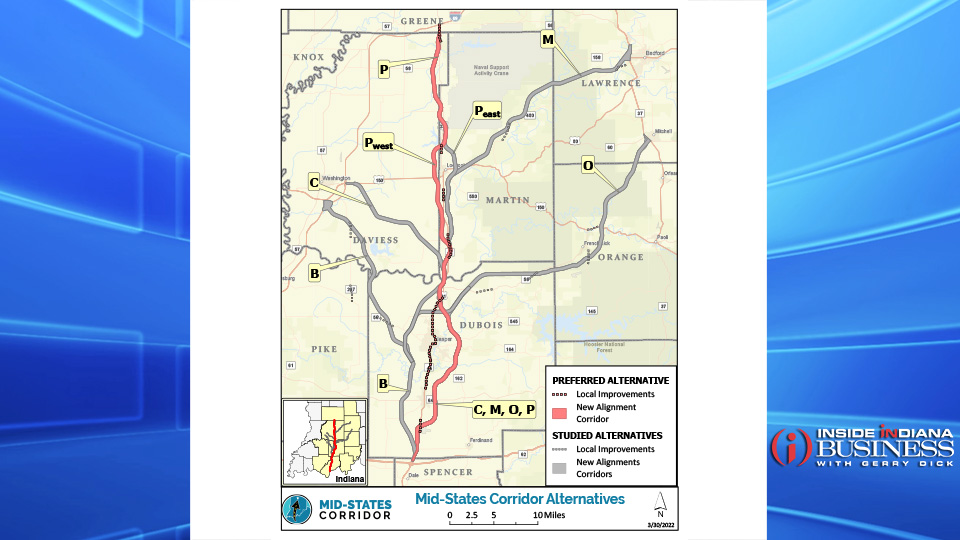Indiana
Indiana budget panel to consider $88M to expand LEAP District plans

INDIANAPOLIS (WISH) — The State Budget Committee on Tuesday will consider spending $88 million to expand a Boone County development project that’s expected to include a research facility for Indianapolis-based pharmaceutical giant Lilly.
The committee’s meeting will come days after Lilly announced it plans to more than double its investment in the research facility. The facility will be part of the Limitless Exploration/Advanced Pace (LEAP) Research and Innovation District in the city of Lebanon.
The state government’s Indiana Economic Development Corp. has asked the committee to “repurpose” $59 million of the $100 million previously allocated to an effort with the code name “Project Nora.” The money would be used to buy another 2,500 acres to support three unspecified projects for the LEAP district. Once the state buys the land, it will be resold to the investors.
The development corporation also wants to “repurpose” $29 million of the $100 million previously allocated to “Project Nora” for road and utility work and other infrastructure to support five projects, including the Lilly facility, in the LEAP district. The other four projects were not specified.
The two “repurpose” proposals are listed as coming from the Deal Closing Fund of the state’s General Fund.
David Ricks, chair and chief executive officer of Lilly, said May 24 during the Indiana Global Economic Summit that the pharmaceutical company was expanding its spending on the Boone County project by $3.5 billion. That would bring Lilly’s total investment to $9 billion.
In May 2022, Lilly first announced its plans to invest $2.1 billion and create up to 500 new jobs in Lebanon. At the Lebanon groundbreaking in April 2023, Lilly announced an additional $1.6 billion investment and 200 new jobs at the Boone County site.
The larger Lilly facility is expected to create what has been called nearly 1,000 “high-wage” jobs in Boone County.
The latest “repurpose” proposals going before the budget committee note the state’s investments will “result in tens of billions of dollars in capital investment and nearly 10,000 jobs being created in the coming years.”
The LEAP project has drawn criticism for a proposal to draw water from other parts of west-central Indiana and move it to the district. As a result, in November, Gov. Eric Holcomb called for more data collection on the proposal to draw and move water. That data effort was expected to be completed in autumn 2024.
The budget committee will meet starting at 9 a.m. Tuesday in Senate Appropriations Room 431 of the Indiana Statehouse in downtown Indianapolis.
Below is from a document of the development/concept plan for the first phase of the LEAP Project in Boone County, Indiana. (Provided Image/Lebanon City Council.

Previous coverage

Indiana
Pierogis not the only star of Pierogi Fest in Whiting, Indiana

Watch CBS News
Be the first to know
Get browser notifications for breaking news, live events, and exclusive reporting.
Indiana
First Tier 2 study for Mid-States Corridor project to begin – Inside INdiana Business

Loading audio file, please wait.
The team behind the Mid-States Corridor Project in southern Indiana has received approval from the Indiana Department of Transportation to proceed with its first Tier 2 study.
The study will be the first of several to determine the alignment and access plan for the new highway, which is being designed to connect I-64 to I-69 through Spencer, Dubois and Martin counties.
The first Tier 2 study will focus on what’s known as Section of Independent Utility 2, or SIU 2, which extends from Interstate 64 near Huntingburg and Jasper to State Road 56 at Haysville in Dubois County.
The goal of the study is to “evaluate more site-specific impacts to determine the specific preferred location and right-of-way needs” for the highway. The study of SIU 2 is expected to take about three years to complete.
Early activity of the study will include survey work and data analysis, the project team said.
Mid-States Corridor rolls forward with business sector support, community blowback
In March 2023, the project team identified a refined preferred route alternative, known as Alternative P, which would run 54 from the I-64/U.S. 231 interchange up to I-69 near Odon.
The Final Environmental Impact Statement (FEIS) issued last September said four new alignment SIUs will each require a separate Tier 2 analysis and are expected to take place sequentially, rather than concurrently.
“Securing and programming funding to complete construction of each SIU may take nine to 15 years in several distinct phases of three to five years,” the FEIS said.
The Tier 2 studies for the remaining SIUs have not been scheduled.
Story Continues Below
Indiana
Parents can safely surrender babies up to 30 days old due to Indiana’s safe haven law

The deaths of two abandoned babies left out in the elements became foundational in establishing Indiana’s Safe Haven Law.
After the discovery of these babies, the state’s opinion on parents who couldn’t care for their babies shifted, which is why there are safe haven laws today.
Here’s what to know.
Baby Ephraim was a baby found dead outside a hospital emergency room on Jan. 26, 2000. He died of hypothermia.
While the parents clearly wanted their baby to receive the care he needed, it was determined that the fear of prosecution is what deterred the parents from handing their child directly to a nurse inside the hospital.
Indiana had been mulling legislation like many states across the country, but Ephraim’s death would solidify their decision and on March 24, 2000, then-governor Frank O’Bannon signed the Indiana law.
Although the law didn’t exist to help Ephraim, it should have saved Baby Jacob.
Just a year later, on Dec. 8, 2001, Jacob was found dead in a trashcan by workers outside a laundromat. He was wrapped in a sheet, several shopping bags and a trash bag. He still had his umbilical cord attached to his tiny body.
At this point, Indiana’s Safe Haven law had been enacted for 18 months, but few people in Indianapolis knew. Jacob’s death would change that by prompting a widespread awareness campaign.
Read the full story: 2 babies found dead outside were buried in unmarked graves. How they changed Indiana law
Indiana’s Safe Haven Law allows for the anonymous surrender of an infant 30 days old or younger without prosecution. Infants may be surrendered at fire departments, hospitals and emergency medical services stations. So long as there are no signs of intentional abuse or neglect, the person surrendering the child is not required to provide any information.
Developed by Monica Kelsey, who learned as an adult that she had been abandoned at a hospital after birth, safe haven baby boxes are devices installed in an exterior wall of fire stations or hospitals that allow for the anonymous surrender of an infant. The first box was installed at a fire station in Woodburn, Indiana, near Fort Wayne, in 2016.
The device is a two-way box, with a door inside and outside the building. The boxes are temperature controlled and programmed with several silent alarms to alert first responders. A silent alarm is triggered when the outside door is opened, when the baby is placed in the bassinet and again when the door is closed and automatically locked.
First responders retrieve the baby from inside the building and transport the infant to an area hospital for medical evaluation. The Department of Child Services then assumes custody of the child.
Do people actually use safe haven baby boxes?
Yes. In 2017 and 2018, babies were surrendered in a box at a Michigan City, Indiana, fire station. Delays in construction meant a box was still not ready when a baby was surrendered at Decatur Township Fire Department on Indianapolis’ southwest side in 2018. The infant was found healthy.
In October of 2023, IndyStar reported that a baby box in Carmel was one of the most used in the country.
According to Kevin Albin from Safe Haven Baby Boxes, 2 babies have been surrendered via baby boxes in the state this year, with many more being surrendered directly to personnel using the national crisis hotline.
Previously: More infants are left in this Indiana baby box than anywhere else in the country
In Indiana, parents can surrender babies that are up to 30 days old either face to face or via baby boxes without facing prosecution.
You can check Safe Haven Baby Box’s website to find the nearest baby box.
Katie Wiseman is a trending news intern at IndyStar. Contact her at klwiseman@gannett.com. Follow her on Twitter @itskatiewiseman.
-

 World1 week ago
World1 week agoOne dead after car crashes into restaurant in Paris
-

 Midwest1 week ago
Midwest1 week agoMichigan rep posts video response to Stephen Colbert's joke about his RNC speech: 'Touché'
-

 News1 week ago
News1 week agoVideo: Young Republicans on Why Their Party Isn’t Reaching Gen Z (And What They Can Do About It)
-

 Movie Reviews1 week ago
Movie Reviews1 week agoMovie Review: A new generation drives into the storm in rousing ‘Twisters’
-

 Politics1 week ago
Politics1 week agoFox News Politics: The Call is Coming from Inside the House
-

 News1 week ago
News1 week agoIn Milwaukee, Black Voters Struggle to Find a Home With Either Party
-

 News1 week ago
News1 week agoVideo: J.D. Vance Accepts Vice-Presidential Nomination
-

 World1 week ago
World1 week agoTrump to take RNC stage for first speech since assassination attempt
















